
EDIBLE LEAVES IN PAPUA NEW GUINEA
The leaves of many plants, wild and cultivated, are eaten by the inhabitants of Papua New Guinea; gathered from food gardens or the surrounding bush, cooked in clay or metal pots, bamboo internodes, or in a mumu (earth oven), leaves form a significant part of the diet of the village people. Town dwellers are likely to be deprived in this respect; without enough land to grow much themselves, or access to wild plants, they must depend on markets.
A few of the more common and better known edible leaves are described here; a complete account would be long indeed. Names are a problem. Names in local languages apply in limited areas and are of no help, even in other parts of the country. Only a few of the species here have names in English or Pidgin. Species are therefore designated by botanical names, with other widely known names, if available, appended. There is a generic name, in Pidgin, for leaf vegetables, kumul.
The plants are arranged here more or less in their natural groups, ferns first, then gymnosperms (plants with naked seeds), and finally angiosperms with covered seeds, in their families, these in alphabetical order.
Thanks are due to the Division of Botany, Department of Forests, Las, for permission to use the illustrations reproduced here.
FILICALES (Ferns)
Plants with a creeping or erect rhizome (stem) from which the roots and leaves (fronds) arise; reproducing by small spores borne beneath the fronds.
ANGIOPTERIS EVECTA Hoffm. Found in lowland forest, particularly in damp places, sometimes common. The curled, thick, tender, emerging fronds (croziers) are eaten after cooking. | 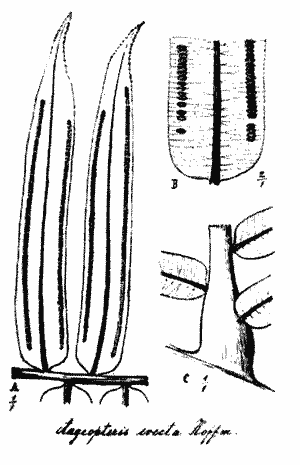 |
| Fig.1 Angiopteris evecta |
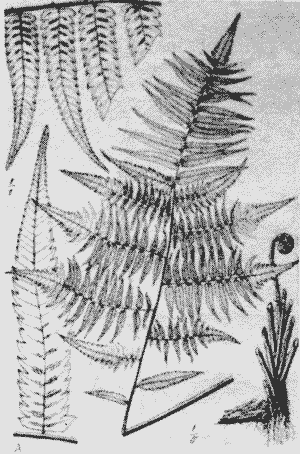 | DIPLAZIUM ESCULENTUM (Retz. )Sw ... kumul-gras (P) In open places, on damp soil at low altitudes, particularly on land which is sometimes flooded; a weed in wet pasture. The tender, newly-opened fronds are a popular vegetable, sometimes sold in markets. |
| Fig.2 Diplazium esculentum |
PTERIDIUM ESCULENTUM L. Kuhn ... Bracken (E)
Rhizome underground, creeping. Fronds 30cm to 1.5m tall, arising singly but close together; stalk erect, hard; mature pinnae firm, dark or greyish green.
Widespread in both hemispheres; in New Guinea, mostly at altitudes of 500 to 2500m, in open grassy places on well-drained soil. A weed of cultivation and pastures, toxic to cattle. The curled, emerging fronds are gathered, and eaten after cooking.
PHANEROGAMS (Flowering plants)
Plants having flowers with male and female organs, together or in separate flowers, or even on separate plants; seed plants.
GYMNOSPERMS
Flowers consisting only of stamens or ovules, in spikes, cones or catkins; ovules not enclosed by an ovary.
Fam. GNETACEAE: Male flowers consisting of one or more stamens on a stem-like support; female flowers consisting of naked ovules in the axils of scales.
GNETUM GNEMON L ..... Tulip (P) The tree is found at low altitudes, wild in forest, or cultivated about villages; propagated by seed, which may take almost 12 months to germinate. A tough fibre is extracted from the bark, used to make fishing line, or string for weaving fishing nets, bilums (string bags) and dancing masks. The young leaves are cooked directly, or used for wrapping other food for cooking. The flesh of the seed is edible, and the stone, after cooking and pounding. | 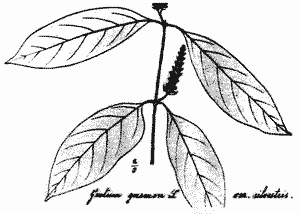 |
| Fig.3 Gnetum gnemon |
ANGIOSPERMS
Seed borne within an ovary, forming a fruit: or grain.
Fam. ACANTHACEAE: Herbs or shrubs, leaves opposite. Flowers with tubular 5-lobed corolla, symmetrical in one plane only. Many are well known as ornamentals: Asystasia, Justicia, Thunbergia.
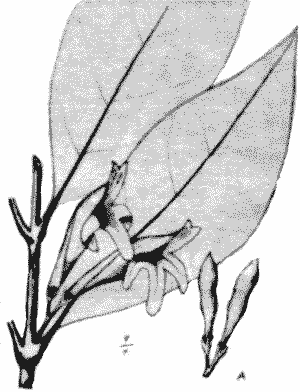 | GRAPTOPHYLLUM PICTUM L. Griff. Cultivated in gardens and about villages (coloured forms) or wild in forest (green form); propagated by cuttings. In New Guinea, from low altitudes to about 1000m; used as an ornamental throughout the tropics. The leaves are gathered and eaten after cooking. |
| Fig.4 Graptophyllum pictum |
RUNGIA KLOSSII S. Moore Cultivated as a pot herb from 1500 to over 2000m, and very popular within its range. Propagated by stem cuttings, and persistent once established, so found wild in abandoned gardens, at roadsides and along streams. The species is native to New Guinea, probably endemic. | 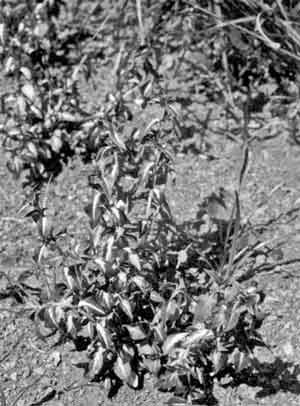 |
| Fig.5 Rungia klossii |
Fam. AMARANTHACEAE: Herbs, leaves alternate or opposite. Flowers small, with a single, papery perianth, usually colourless or greenish but sometimes red or yellow. Amaranthus, Celosia (Cockscomb) and Gomphrena (Batchelors' buttons) are grown as ornamentals and some species are widespread as weeds.
AMARANTHUS ... Aupa (P)
Annual herbs, usually erect; leaves alternate. Flowers in dense clusters or tassels. Seed small, shiny black or (rarely in New Guinea) white.
Several species are cultivated for the leaves, which are boiled alone or cooked with other food. Propagation is by seed; often, a bundle of mature plants is tied to one of the rafters of a hut, and broken up over the garden at planting time, to grow among the other, perennial plants there.
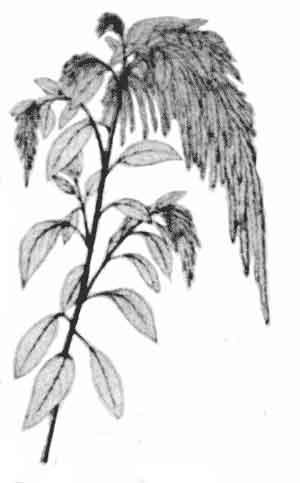 | AMARANTHUS CAUDATUS L. Cultivated at altitudes over 2000m, in the Western Highlands of Papua New Guinea. It is probably a recent introduction; native to South America, where it is grown for grain. In New Guinea, only the leaves are used. |
| Fig. 6 Amaranthus caudatus |
AMARANTHUS CRUENTUS L.
Erect herb, to over 1m tall. Flowers clustered in lateral compound spikes, above in dense, stiff panicles. Seed black, shining, about 1mm across.
Cultivated from 1200 to 2299m altitude. Native to Central America.
AMARANTHUS DUBIUS Thell.
Erect herb, to over 1 m tall. Flowers in lateral compound spikes, above in rather lax panicles. Seed black, shining, about 1mm across.
Cultivated from low altitudes to 1300m, also a weed in plantations and garden areas. Native to Central America.
AMARANTHUS LIVIDUS L.
Erect to spreading herb, to 60cm tall. Flower clusters single or arranged in compound spikes. Seed black, but falling within the capsule, which is greyish with a dull surface.
A widespread weed, from 1200 to 2000m. The leaves are gathered for cooking but the plant is not, or rarely, cultivated. World-wide in warm regions.
AMARANTHUS TRICOLOR L. Cultivated from low altitudes to 2000m, popular, and found for sale in markets, sometimes as bundles of very young plants; also widespread as a weed. Native to Southern Asia and Malesia, now in most warm regions of the world. | 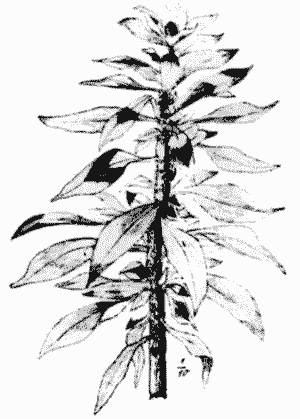 |
| Fig. 7 Amaranthus tricolor |
AMARANTHUS VIRIDIS L.
Erect or spreading herb to 75cm tall. Flowers in single clusters or compound spikes. Seed black, shining, but usually falling within the wrinkled capsule.
Rarely cultivated, but a common weed from low altitudes to 2000m and widely used as a green vegetable. Origin doubtful, now world-wide in warm regions.
CELOSIA ARGENTEA L ..... Cockscomb (E)
Erect herb to 1.5m tall; leaves alternate, acute at the tip, acute or tapering at the base. In wild plants, flowers in conical heads, which become cylindrical as they develop, pinkish. Ornamental forms, with wide, fasciate inflorescences, red or yellow, have been developed. Seed black, shining, about 1.5mm across.
The ornamental forms are leafy, and, in more or less degenerate phases, may be cultivated for the leaves. Flower-heads of the wild plant yield a yellow dye. World-wide in warm regions; in New Guinea from low altitudes to 1500m.
The leaves of these Amaranthus species, or indeed of any fast-growing, nitrate-hungry plant, should be treated with some caution, as they may contain free nitrates. Nitrate may be reduced to nitrite in the gut, and nitrite can react with the haemoglobin in the blood, blocking its role in the transfer of oxygen to the tissues. It has been suggested that potentially nitrate-rich leaves should not be eaten more frequently than once a week. Overcast, rainless weather, with fairly high temperatures, seems to increase the accumulation of nitrates in plants.
No case of human poisoning by nitrates is known to have been reported from New Guinea (except where a mixture containing potassium nitrate was accidentally given to babies in a hospital) but two horses died after being fed bundles of a fast-growing grass, Rottboellia exaltata, cut at a roadside near Port Moresby. The blood after death was brownish, in contrast to the bright-red colour after poisoning by cyanide, which also reacts with haemoglobin.
Nitrates are soluble, so cooking in ample water should remove any danger.
Fam. ARALIACEAE: Shrubs or trees, leaves alternate, usually compound. Flowers small, green or greenish yellow (or red) in umbels (the flowers on stalks which arise from a common centre, giving a flat-topped or umbrella-shaped arrangement; see also Umbelliferae, below) these often combined in compound inflorescences; ovary inferior. Schefflera actinophylla, the Umbrella tree, is well known, and species of Polyscias are grown in gardens as 'Aralia', Parsley plant, etc.
POLYSCIAS CUMINGIANA (Presl) F-Vill.
Shrub, 2-5m tall; leaves 50-100cm long, pinnate with 7 or more leaflets, these 10-15cm long, rather light-green, often variegated with whiteish patches. Flowers in small umbels on the branches of a large terminal panicle.
Cultivated about villages, at low altitudes; propagated by cuttings. The leaves are used for wrapping food for cooking, or themselves cooked as a vegetable; throughout South East Asia, Malesia and the Western Pacific, and worldwide as an ornamental in tropical regions.
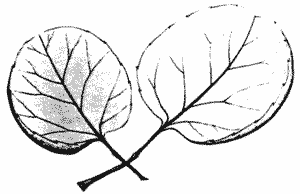 | POLYSCIAS SCUTELLIFERA (Burm.f.) Fosberg Cultivated at low altitudes, propagated by cuttings. The leaves are cooked as a vegetable, used for wrapping food and as plates. Malesia and the Western Pacific, widespread as an ornamental. |
| Fig.8 Polyscias scutellifera |
Fam. ARACEAE: Herbaceous plants, leaves often large, alternate. Flowers small, on a fleshy axis, the spadix, subtended by a white, greenish or bright-coloured leaflike spathe. Well-known garden plants are Anthurium, Caladium, Dieffenbachia (dumb-cane) and Philodendron.
COLOCASIA ESCULENTA L. Schott ... Taro (P.E.) Taro is cultivated as a root vegetable from low altitudes to neatly 2000m. The young leaves are sometimes cooked as a green vegetable. |  |
| Fig.9 Colocasia esculenta |
Fam. COMMELINACEAE: Herbs; leaves alternate, with parallel veins; above the leaf-base, a cylindrical organ, the ocrea, sheathing the stem. Perianth-parts in 2 whorls of 3 each, the lower whorl green, the upper petaloid, larger, white, blue or purple. Garden plants are Dichorisandra, Rhoeo (Moses in the bulrushes), Tradescantia and Zebrlna (Wandering Jew).
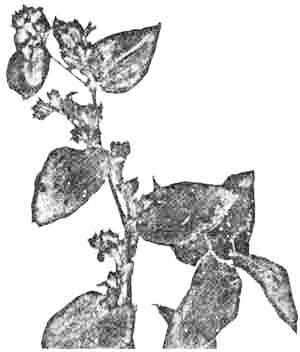 | CYANOTIS MOLUCCANA Merr. The species ranges from Java to the Solomons, and is variable. The description above refers to a cultivar, which seems to be known only in New Guinea, mostly at altitudes from 1700 to 2500m. It is planted about villages and in food gardens, propagated by pieces of stem; it persists, once established, and may be seen at roadsides and along streams. It is used as a pot-herb, and medicinally; one collector (Dr. N. Bowers) remarked "a seasoning for pork, along with ginger and native salt". "Native salt" refers to a kind of salt (containing more potassium than sodium) made in the New Guinea Highlands, by burning selected grasses and other plants, leaching the ash with water, then concentrating the resulting solution by boiling until the dissolved salts crystallise out. |
| Fig. 10 Cyanotis moluccana |
Fam. CONVOLVULACEAE: Mostly twining vines; leaves alternate. Flowers regular, corolla united, mostly funnel-shaped. The main tropical genus. is Ipomoea, with I. nil and I. purpurea (mornlng glories), I. hederacea and I. quamoclit, small vines with bright red flowers, I. pes-caprae on the beach, and so on.
IPOMOEA AQUATICAForsk .. Water kau-kau(E) Kandong (P, from Malay). This is probably a fairly recent introduction (19th century) from South East Asia, and is seen mostly in cultivation, though it grows wild along major rivers where conditions are suitable: slow-flowing to stagnant water, muddy banks, low altitude. Pieces of stem, planted in mud, rapidly produce shoots which float on and cover pools. It is an excellent and productive green, though the taste is bland; this is improved if it is stir-fried with garlic and salt. | 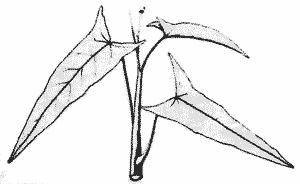 |
| Fig.12 Ipomoea aquatica |
IPOMOEA BATATAS L. Sweet Potato(E), Kau-kau (P)
Creeping herb with tubers; leaves more or less triangular in shape but very variable in detail. Flowers pink, 4-5cm across.
Kau-kau is cultivated for the tubers in New Guinea, and is a staple food in many areas, from low to median altitudes. Propagation is by stem cuttings. Native to South America, it has been in New Guinea for several centuries. The leaves are sometimes cooked as a green vegetable, but are not popular.
Fam. CRUCIFERAE: Herbs; leaves alternate. Flowers with 4 petals, mostly white or yellow, in the form of a cross; stamens 6; fruit 2-valved, or indehiscent. The large genus Brassica contains many familiar vegetables; cabbage, turnip, Chinese cabbage, cauliflower etc.
BRASSICA CHINENSIS Juslenius .. Chinese cabbage (E)
This is not a traditional vegetable, but is usually available in coastal markets, and seems to be grown mainly as a cash crop.
BRASSICA ALBOGLABRA Bailey .. Chinese kale (E)
Like the above, available in markets, and apparently grown for sale.
BRASSICA JUNCEA L. Czern and Cossan. Indian mustard (E) A few plants, often of the more slender kind, are often to be found in food gardens, at low altitudes, but not in quantity, and it is not likely to be found in markets. The pungent-tasting leaves may be eaten raw, preferably with other greens. Native to Southern and Eastern Asia. | 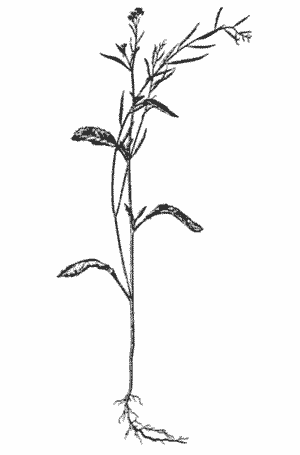 |
| Fig.13 Brassica juncea |
BRASSICA OLERACEA L. Cabbage (E), Kabis (P)
Strains of cabbage are available which will form a heart even at low altitudes, but the more familiar kinds, along with Brussels sprouts, cauliflower and broccoli, do best from 1800m upward. Cabbage has become popular as a domestic vegetable in the Highlands, but the other sorts, if grown, are intended for sale.
Cabbages are usually grown from seed, but villagers also grow them from stem cuttings.
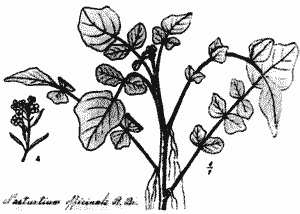 | NASTURTIUM OFFICINALE R.Br. Water Cress (E) A native of the northern hemisphere, introduced to New Guinea probably late last century, cultivated from low altitudes to 2500m, propagated by stem cuttings, planted in shallow running water. It is persistent once established, but it is much more vigorous at the higher altitudes, and its existence in lowland areas is precarious because of the more variable, often heavy, rainfall; larger streams may wash it away, smaller ones dry up. It may be cooked with other vegetables or eaten raw. |
| Fig.14 Nasturtium officinale |
European vegetables were introduced to the northeast part of New Guinea in the seventies of last century, by Maclay, the Russian who lived for some time on what is now known as the Rai (for Maclay) coast. A German anthropologist, working about 10 years ago in the Chimbu region, on the slopes of Mount Wilhelm (a long way from the sea) stated that some of the vegetables grown there, peas, cucumbers, pumpkins and others, had names in the local language which resembled the Russian names so much that he was convinced that the progeny of Maclay's seeds had penetrated there, with the names he gave them.
RORIPPA The leaves have a cress-like flavour and seem to be usually eaten raw. Propagation is by seed, by the traditional method, of keeping a bundle of dry plants under the house eaves, and breaking it up over a newly-cleared garden. | 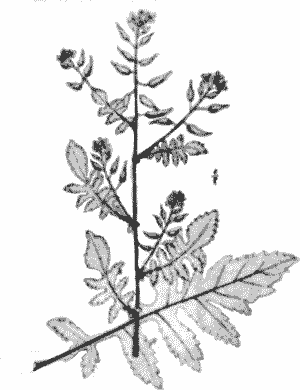 |
| Fig. 15 Rorippa sp. |
Fam. COMPOSITAE (ASTERACEAE): Herbs, shrubs or trees; leaves alternate or opposite. Flowers collected into heads, surrounded by bracts; in the heads, the inner, sometimes all, flowers with a tubular corolla, the outer row of flowers, often with the corolla ligulate, with one side of it expanded to a strap-shaped section, which may be bright-coloured. Fruit 1-seeded, often with a pappus of hairs at the apex for wind dispersal, or this modified to rough or hooked hairs. A very large family, including many ornamentals (Dahlia, Chrysanthemum, various daisies), economic plants, sunflower and numerous weeds.
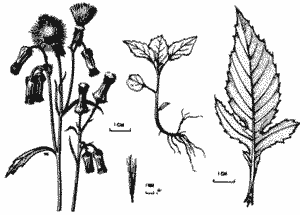 | CRASSOCEPHALUM CREPIDIOlDES (Benth.) S. Moore. Thickhead (E) This plant is a newcomer on the New Guinea scene. Native to tropical Africa, it probably arrived not long before 1940. By 1955 it was widespread in P.N.G. from sea level to 2500m, used as a pot herb by village people and given names in the vernacular. It is essentially a weed of cultivation, persisting for several months on abandoned gardens, disappearing as grasses develop. It was never popular near the coast, but is still used in some highland areas. |
| Fig.11 Crassocephalum crepidioides |
Fam. CUCURBITACEAE: Creeping or climbing plants with tendrils, mostly herbaceous; leaves alternate. Flowers separately male and female, on the same or different plants; corolla usually united, tubular or bell-shaped, mostly yellow or white. Familiar plants are pumpkins, Cucurbita, and melons and cucumbers, Cucumis.
CUCURBITA .. Pumpkin (E) Bankin (P)
The three species of pumpkin, C. maxima Duch., C. moschata (Duch.) Poir. and C. pepo L., are all present in New Guinea and some forms may persist for a long time after cultivation. The fruit is not popular, but the stem-tips, with developing leaves, make a pleasant green vegetable, used domestically and sold in markets.
SECHIUM EDULE (Jacq.)Sw. Choko (E) Shoke (P)
When available, the stem-tips of choko are used in the same way as pumpkin-tips; and are preferred. Native to tropical America, introduced to New Guinea about the end of last century, it is now widely cultivated, and naturalised in some localities.
In the Wampit valley, on the road between Lae and Wau, patches of wild choko have become established on the hillsides, at altitudes from 500 to 800m, overcoming garden regrowth and preventing the regeneration of trees. The local people make use of this resource; bundles of tips are sold by the road, and taken to the market at Lae.
DATE: September 1987
* * * * * * * * * * * * *
